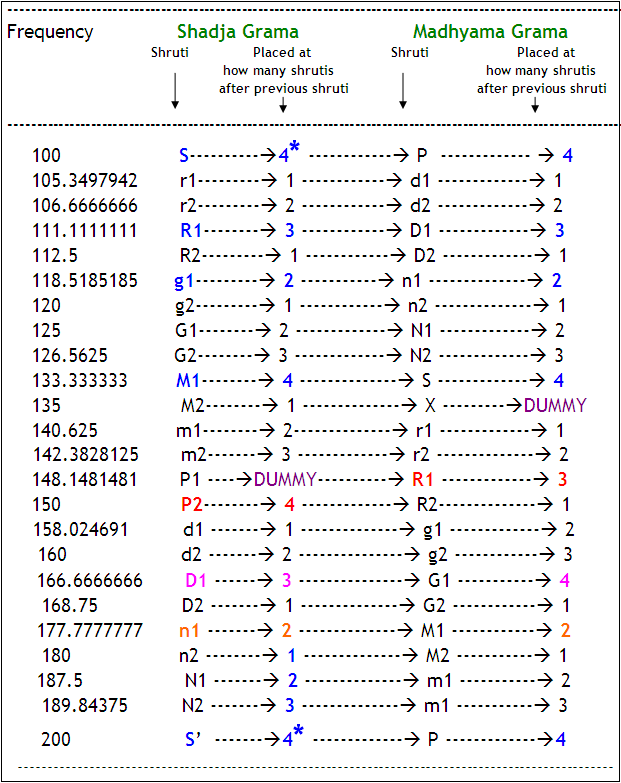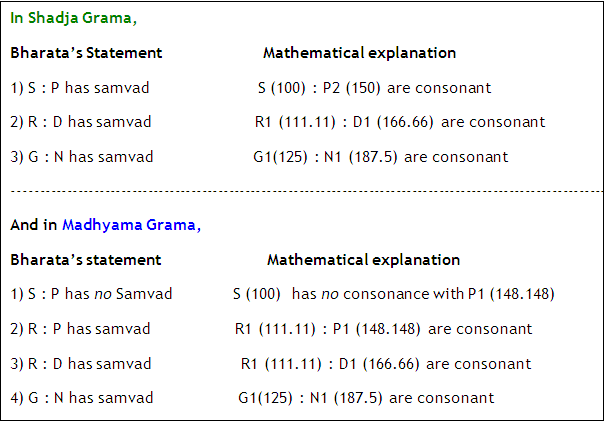Bharata's statements in Natyashastra (Chapter 28, Shlokas 23,24,25) about Shadja and Madhyama Gramas, the sequence of Shrutis and their mathematical explanations is provided here.
Bharatamuni stated in Natyashastra that:
"ChatushChatushChatushchaiva; Shadja, Madhyam, Pancham; DvaiDvai Nishad Gandharou; Trishri Rishabha Dhaivatashcha'"
This is translated as "there are 4 (Chatush meaning 4) Shrutis each for Shadja, Pancham and Madhyam, 2 (Dvai meaning 2) each for Nishad and Gandhar, and 3 (Trishri meaning 3) each for Rishabh and Dhaivat.
And, this is wrongly interpreted as Shadja, Madhyama and Panchama have 4 'variants' (different frequencies) each, Nishad and Gandhar have 2 each, and Rishabha and Dhaivata have 3 each.
But how can this be true?
How can Shadja Madhyama and Pancham each have 4 different frequencies?
Shadja, Madhyama and Pancham have only 1 frequency each at 100, 133.3333 and 150 respectively!
The citation must therefore have another meaning.
And that true meaning is, Shadja is "placed at a distance of 4 shrutis" after it's previous note, n1. Similarly, 3 shrutis of Rishabha (R1) means Rishabha is placed 3 shrutis after Shadja, and so on. In other words, the Shruti divisions are "Sequential" (as shown in the table below) and not "Differential".
(Unfortunately, the above shloka (citation) is still taken literally, misinterpreted and some stalwarts wrongly believe and even sing 4 different shrutis for Shadja, Madhyama and even for Panchama today! This is a sad story.)
To understand what Bharata said, firstly, Bharata's Shadja Grama and Madhyama Grama are explained below. Grama simply means a scale (a group of notes) starting from a particular note. e.g., Shadja Grama means scale starting from Shadja (1st note) and Madhyama Grama means scale starting from Madhyama (4th note)
However, while shifting from Shadja to Madhyama Grama, the Rishabha (R) in Madhyama Grama (i.e., after shifting S on M1), changes as shown below.
We must remember first that at the time of Bharata, the 7 note Indian scale consisted of S, R1, g1, M1, P, D1, and n1.

It can be seen that Rishabha present as R1 in Shadja Grama automatically changes to R2 in Madhyama Grama.
Therefore, to keep similarity of Rishabha at 111.11 also in Madhyama Grama, Bharata suggested that Panchama (of original Shadja scale i.e., P2) should be reduced by 1 shruti in Madhyama Grama .
This can be accomplished by reducing P2 from 150 to P1 = 148.148148148, which brings Rishabha at the same distance at 111.11 also in Madhyama Grama as shown below

Bharata further stated that the extent of this reduction should be termed as the "PRAMANA SHRUTI" and today we can demonstrate that, this is equal to 150/148.148148 = 1.025 !
Thus, according to Bharata, because of the change from P2 to P1, the sequence of shrutis in the 2 Gramas changes as shown below. This table is very important and unfortunately quite poorly understood by many. Please read the explanations provided below the table to get a correct understanding of what Bharata meant. It shows how a shruti from P (in Shadja Grama) is passed on to D (in Madhyama Grama).

Table showing "Sequential" positioning of Bharata's Shrutis.
For him, Shruti was simply an expression of "Distance from previous Note". (To reiterate, at the time of Bharata, the 7 note Indian scale consisted of S, R1, g1, M1, P, D1, and n1.)
In the above table, DUMMY means the shruti which has to be omitted in that Grama as this position is superfluous.
The above table can be understood by explanations as below which must be read patiently and carefully.
- 1Bharata said that Shadja or S' is on 4th Shruti. People have unnecessarily quarelled questioning how can shrutis arise 'before S' if S is the 1st shruti ! We can see in the table that this S' is on 4th shruti from n1 of the previous Saptak (Octave). This simply means that S comes 4th (or on the 4th shruti) after n1 of the lower Octave or Mandra Saptak).
- 2It is said that S in Shadja Grama 'has' 4 Shrutis and that corresponds to 4 shrutis in Madhyama Grama too. (Actually this only means that S 'sits at' a distance of 4 Shrutis (from n1) in Shadja Grama and also sits on the same distance of 4 shrutis in Madhyama Grama too. This does not mean that S has 4 variants (frequencies) as is wrongly believed and interpreted and even sung by some teachers !)
- 3Further, R1 in Shadja Grama sits on 3 Shrutis from S and that corresponds to 3 shrutis in Madhyama Grama too.
- 4Going ahead, g1 in Shadja Grama sits on 2 Shrutis from R1 and that corresponds to 2 shrutis in Madhyama Grama too.
- 5Going ahead, M1 in Shadja Grama sits on 4 Shrutis from g1 and that corresponds to 4 shrutis in Madhyama Grama too.
- 6The difference in 2 the Gramas starts now.
- 7Panchama in Shadja Grama sits on P2. This P2 in Shadja Grama sits on 4 Shrutis after M1, but since this P2 is changed to P1 in Madhyama Grama corresponding to R1, it sits on 3 shrutis (after M1) in Madhyama Grama.
- 8Going ahead, D1 in Shadja Grama sits on 3 Shrutis after P2 but sits on 4 shrutis in Madhyama Grama.
- 9Lastly, n1 in Shadja Grama sits on 2 Shrutis after D1 and sits on 2 shrutis in Madhyama Grama too.
The confusion about 'which' is the '1st' shruti is worthless. Since to get S on 4th shruti, (as stated by Bharata), n1 will have to be the '1st' shruti.
But some argue as to how n1 can arise at all in the absence of S? For them, S is taken as the starting point, N2 will be the 22nd shruti and S' will be on the '23rd' shruti.
In any case, what is important is that the distances and the frequencies of 22 shrutis in both Gramas from respective Shadjas do not change!
Thus, the no. of shrutis on which the Swaras are placed (as shown by Bharata) is as below. The difference in no. of shrutis in 2 Gramas is highlighted in colour again.

Further, some of the important statements of Bharata and their mathematical explanation is given below.

Thus, when Bharata said that S 'has' 4 shrutis, it only means that S sits at a distance of 4 shrutis from n1…and so on. It does not mean that S has 4 different frequencies !!
Bharata probably saw Madhyama Grama as a proper scale for singing by females, whos' voices are approximately at a 50% higher pitch than males.
For this Female scale of Madhyama Grama, he therefore had to reduce P2 from P1 to strike a similarity of Rishabha (to reside at 111.11 as R1) in both Gramas.
Thus, Bharatamuni's division of 22 shrutis in Shadja and Madhyam Gramas can be understood without any confusion.

